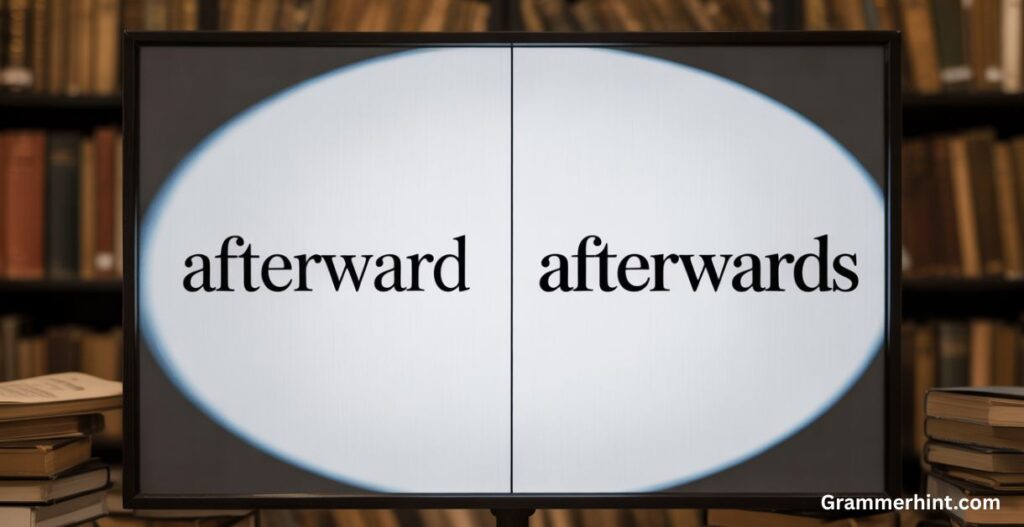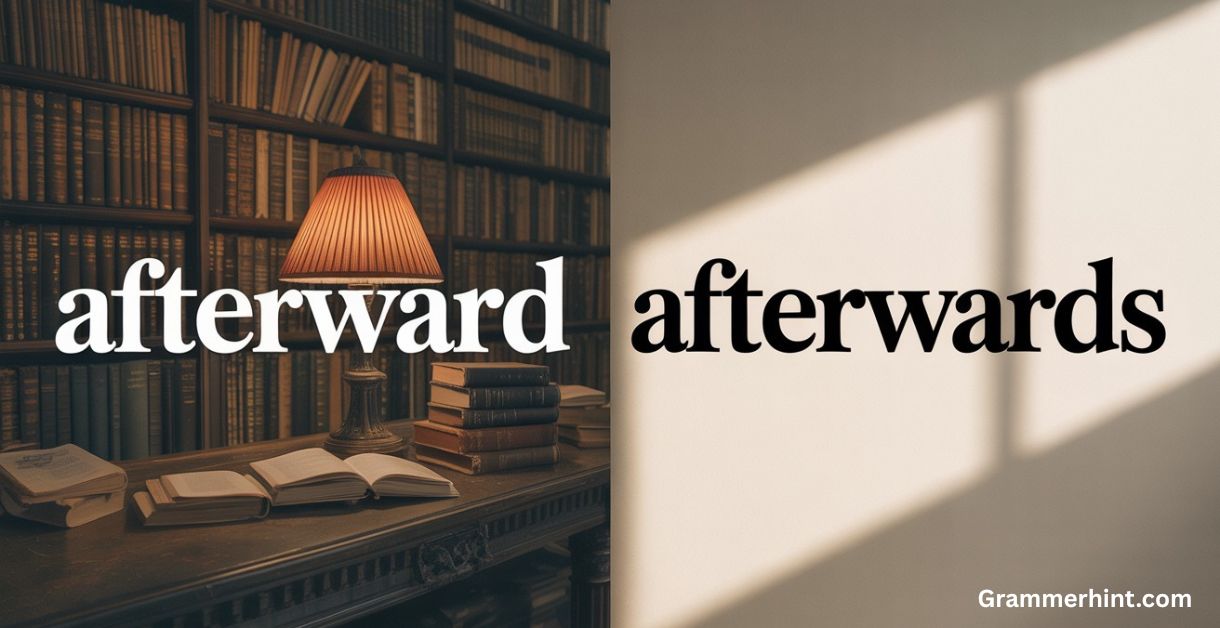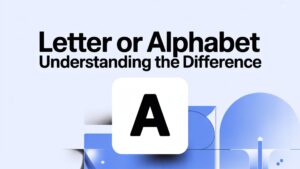In the world of English grammar, even the smallest variation in word endings can spark confusion. One common debate involves the words afterward vs afterwards.
Are these simply two different spellings of the same word? Or is there a deeper, more nuanced difference between them?
Let’s dive into the grammar and usage, explore the evolution of English words, and provide contextual examples in grammar to settle the question: “Is it afterward or afterwards?”
Understanding the Basics: What Do “Afterward” and “Afterwards” Mean?

Both afterward and afterwards are temporal adverbs they indicate a point in time following an event. In most contexts, the meaning is the same:
“We had lunch, then afterward took a relaxing bath.”
“We had lunch, then afterwards went shopping.”
In both sentences, the words describe an event followed by another.
So at a surface level, the difference seems minimal. But let’s not stop there.
Key Definition and Meaning
- Afterward (adverb): at a later or subsequent time; subsequently.
- Afterwards (adverb): also means later or subsequently.
This creates immediate confusion for learners and even native speakers. Afterward or afterwards? Are they fully interchangeable?
Let’s examine the key areas where afterward vs afterwards may differ.
The Real Difference: American English vs British English
This is where we hit the core of the matter.
- Afterward is more commonly used in American English usage.
- Afterwards is more typical in British spelling conventions.
“Is afterwards British or American?”
It’s British.
Examples:
- US: “We’ll go for a walk, and afterward we can grab a coffee.”
- UK: “We’ll go for a walk, and afterwards we can grab a coffee.”
Both are grammatically correct. The choice depends on your audience and region. If you’re writing for an American audience, go with afterward. If your content is tailored for UK readers, afterwards is the preferred spelling.
Email Scenario Examples
Example 1 – American Style Email:
Subject: Project Debrief
Hi Sandra,
Thanks again for leading the workshop today. Everyone seemed highly engaged.
Afterward, we had lunch with the stakeholders and reviewed some of the key findings. I’ll send out a detailed summary shortly.
Best,
Jason
Example 2 – British Style Email:
Subject: Follow-up on Strategy Session
Hi Thomas,
Great discussion this morning.
Afterwards, we met friends for coffee and continued talking about implementation plans. I’ll prepare notes and share them by tomorrow.
Cheers,
Emily
These examples demonstrate audience-targeted writing. The variant you choose afterward or afterwards — should align with the correct regional form.
Suffix Usage in English (-ward vs -wards)
This difference in spelling traces back to suffix usage in English. The choice between -ward and -wards is a well-documented pattern:
| Directional Base | American English | British English |
|---|---|---|
| toward | toward | towards |
| backward | backward | backwards |
| upward | upward | upwards |
| inward | inward | inwards |
| afterward | afterward | afterwards |
These forms show a regional language difference and reflect broader trends in English dialect preferences.
Why Does This Matter?
Because spelling choices can impact your writing clarity and coherence especially in international communication.
Usage in Sentences: More Examples
Here are more contextual examples in grammar:
- “Afterward we had lunch” used in a timeline report.
- “Then afterward sent out an email” casual note format.
- “Afterwards went shopping” informal recounting.
- “Afterwards met friends for coffee” daily planner or blog style.
These examples help illustrate the post-event description that these adverbs signal key in sequence of events.
Temporal Adverbs: Definition and Role
Both words fall under adverbial time expressions, indicating when something happens.
Other Common Temporal Adverbs:
- Later
- Subsequently
- Eventually
- Soon after
- In the wake of
- Following
Each carries subtle differences in tone or specificity. Comparing afterward vs afterwards in this context shows they’re part of a broader set used for timeline narration.
When Style Guides Matter
When choosing afterward or afterwards, your writing style guide is crucial.
Examples:
- Chicago Manual of Style (American): prefers afterward.
- Oxford Style Manual (British): uses afterwards.
If you’re submitting to a publication or writing for a brand, refer to their editorial guidelines to ensure writing consistency.
Formal vs Informal English: Which One Fits?
In formal vs informal English, both versions can be acceptable.
However, afterward tends to feel slightly more formal or professional — especially in the U.S.
- Formal: “The meeting concluded. Afterward, the minutes were distributed to all participants.”
- Informal: “We wrapped up the event. Afterwards, we went for drinks.”
Your tone and context matter.
Preferred Spelling in Professional Writing
When you’re writing for a business, journal, or global audience, preferred spelling may not just depend on region, but on consistency across a document.
Best Practices for Regional Spelling Consistency in Writing:
- Pick a standard (American or British).
- Apply it across the document.
- Avoid mixing variants like color/colour, organize/organise, afterward/afterwards.
Evolution of English Words and Variants
The evolution of English adverbs from Old English to Modern has created such variation. The -wards ending has older roots and was once used more broadly. Over time, American spelling conventions trimmed some forms (e.g., afterward, toward), possibly for conciseness and clarity.
This fits the trend of English morphology where suffixes streamline over time.
ESL Tips: Which Should Learners Use?
For learners of English (ESL tips), choose based on the dialect you’re studying:
- Learning British English? Use afterwards.
- Learning American English? Use afterward.
Also, remember the adverbial suffix variation: both are correct, just context-dependent.
Summary Table: Afterward vs Afterwards
| Feature | Afterward (US) | Afterwards (UK) |
| Spelling Origin | American | British |
| Usage Style | More formal | More conversational |
| Common In | Business writing | Daily dialogue |
| Style Guide | Chicago Manual | Oxford Manual |
| Sentence Example | “Then afterward…” | “Then afterwards…” |
Alternatives to Use
Sometimes, choosing a synonym avoids the dilemma. Try:
- Later: “We’ll meet later.”
- Subsequently: “He subsequently joined us.”
- Thereafter: “Thereafter, nothing was the same.”
- Following: “Following the meeting, we had lunch.”
- Soon after: “Soon after, the rain began.”
- Eventually: “Eventually, she replied.”
- After a while: “After a while, he left.”
- In the wake of: “In the wake of the announcement, changes followed.”
These options improve writing clarity and coherence by avoiding repetition.
Final Thoughts: Is It Afterward or Afterwards?
The bottom line?
Afterward and afterwards mean the same thing — both are correct, both are useful. But your choice should depend on:
- Audience expectations
- Regional spelling standards
- Style guide alignment
Always consider:
- “Usage depends on your audience”
- Choose the correct regional form
- Maintain language consistency









